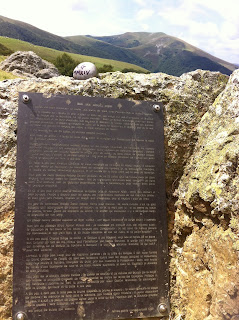 The Estacion de Autobuses in Pamplona provided welcome shade one concrete level below the esplanade.
The Estacion de Autobuses in Pamplona provided welcome shade one concrete level below the esplanade.We, homeward bound after a week's walking, joined the newly-arrived, and mainly American, peregrinos. Their pristine walking-gear contrasted with our camino-worn garb.
We queued to buy 16 Euro's worth of one-way ticket in the wrong direction, back to St Jean Pied-de Port on the French side of the Pyrenees.
Considering the white-knuckle experience the next ninety minutes would provide, and the rising cost of fairground terror, the price was something of a bargain.
Suzi, five-foot three, lean and in her late twenties, parked her Harley-Davidson in front of the staff canteen. A perspex badge on her leather jacket informed us that she was in the employ of the bus company. The jacket matched the tight black trousers, which did little to mask Suzi's gender or the five euros in small change in her back pocket. Her Santiago boots, presently grinding a cigarette-end, may well have been a hushed tribute to the Camino. In any case, they set off her five visible body piercings nicely.
As the bus station clock jolted towards 2 pm, we collectively understood that Suzi was to be our driver.
There was not a murmur from the passengers as she depressed the start button, and the plush interior throbbed to the rythm of eight diesel cylinders. Any mechanical noise was instantly drowned by a wall of sound emanating from the state-of-the-art FM radio amplification, fitted as standard to all Spanish buses.
We emerged from below ground, all eyes rivetted on Suzi's mullet haircut. Forty-eight pilgrim gazes darted from the stream of suicidal Pamplonan 2pm traffic to our chauffeuse's reflexion in her rear-view mirror. Kiss FM roared Lulu, singing "Shout", and we roared, even more loudly, into the flow.
By the time we reached the barrios of Pamplona, it had become clear to all that Suzi was a virtuoso driver. At one point she stopped in a taxi rank, disembarked and held a brief conversation with a handsome Basque cabbie. The exchange ended with broad smiles and a besito.
It was also clear that she considered the coach to be her Harley, only wider.
The road to Zubiri is arrow- straight, following the Arga towards its source. We only overtook two stragglers: a BMW coupé, and a classic, bright red Navarra-registered 1982 Audi Quattro.
After Zubiri, the road climbs over Erro, then descends into Espinal. The hair-pin bends were negotiated with Suzi's tiny, beetle-shiny frame manipulating the cartwheel-sized steering wheel with precisely the amount of oversteer and understeer to keep us in a finely-balanced state of awe and admiration.
She was giving the Quattro driver behind a masterclass lesson in effortless mountain driving.
She was giving the Quattro driver behind a masterclass lesson in effortless mountain driving.
He was still behind when Suzi stopped in the middle of Burguete and with both wing-mirrors just centimetres from the immaculate geranium windowboxes, to pick up a Spanish pilgrim. He had been standing in the middle of the road holding aloft a ten euro note.
Our driver smiled, he gave her the note, and she removed five in change from that back pocket. He quickly slid the coins into his jeans, and examined his palm, as if looking for burn marks.
FM gave us Dusty Springfield as we approached the monastery.
There was no-one waiting to embark at Roncesvalles, so we blasted through, the Audi still behind us.
 The radio switched to a succession of slower tunes as we crested the Ibañeta pass, and headed downhill.
The radio switched to a succession of slower tunes as we crested the Ibañeta pass, and headed downhill.
Bonnie Tyler...Time After Time
Through the roadworks in Valcarlos, over the stream and the invisible border at Arnéguy where, suddenly, all is French.
Ten minutes later, right on schedule, we reversed into the bus-bay next to the ancient town gate.
As we alighted, the driver of the Audi walked over from the public car park as if in a trance, took out a packet of Fortuna, and offered one to Suzi.
She unzipped the tight breast pocket of her jacket, then pulled out a disposable lighter.
With a single flick, Suzi looked up and held a steady yellow flame towards him...
With a single flick, Suzi looked up and held a steady yellow flame towards him...






























